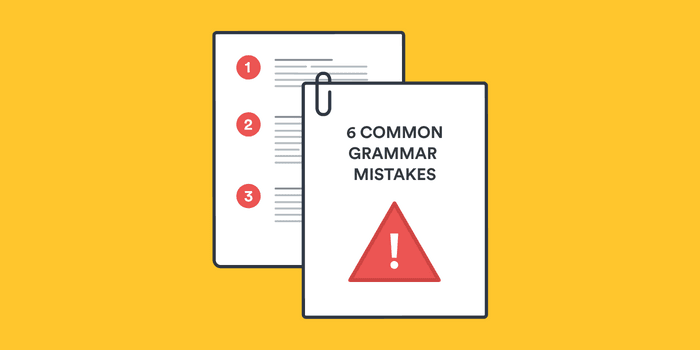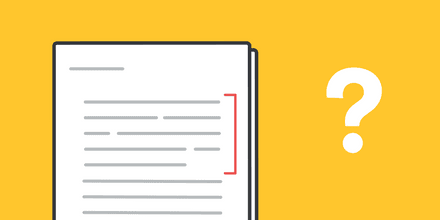
Good grammar is essential for effective communication, especially in academic writing. However, even the best writers can make mistakes. In this post, we'll discuss some of the most common grammar mistakes and provide tips on how to fix them.
Common grammar mistakes
Here are six of the most common grammar mistakes and how to fix them:
1. Subject-verb agreement
One of the most common grammar mistakes that academic writers make is confusing subject-verb agreement. The subject of a sentence should agree with its verb in number (singular or plural). For example, "The dog barks" is correct, while "The dog bark" is incorrect.
To fix this mistake, identify the subject of the sentence and make sure that the verb agrees with it in number. Proofread your work to ensure that you haven't accidentally switched between singular and plural forms.
2. Misusing apostrophes
Another common grammar mistake is misusing apostrophes. Apostrophes are used to indicate possession or to show where letters have been omitted in a contraction. For example, "the dog's bone" indicates that the bone belongs to the dog, while "can't" is a contraction of "cannot."
However, many people use apostrophes incorrectly to pluralize words (e.g. "apple's" instead of "apples") or to indicate the possessive form of a pronoun (e.g. "your's" instead of "yours"). If you’re unsure about how to use an apostrophe, ask your instructor or consider going to your school’s writing center.
3. Confusing homophones
Homophones are words that sound the same but have different meanings and spellings. For example, "their," "there," and "they're" are all homophones, but they have different meanings and spellings.
To avoid confusing homophones, make sure to double-check the spelling and meaning of a word before using it.
4. Run-on sentences
Run-on sentences are sentences that are too long and contain too many ideas. They can be difficult to read and understand, and can make your writing appear disorganized.
To fix this mistake, break up long sentences into shorter, more manageable ones. Use punctuation, such as commas or semicolons, to separate ideas. Try to use clear, concrete, and concise language. The best way to test if you have run-on sentences in your paper is to read it aloud.
5. Using commas incorrectly
Commas are used to separate ideas and make writing easier to read. However, many people misuse commas or use them too frequently.
To fix this mistake, make sure to use commas correctly. Use them to separate items in a list, to separate clauses in a sentence, and to set off nonessential information. However, avoid using them unnecessarily, as this can make your writing appear cluttered and difficult to read.
6. Faulty predication
A sentence has two main parts: a subject and a predicate. As writers progress to writing longer and more complex sentences, they often compose sentences with mismatched subjects and predicates. Faulty predication can be hard to catch, but it’s one of the most common mistakes that academic writers make.
For example, the sentence, “in 1887, the release of more information became available” uses faulty predication. To catch the error, you need to carefully pull out the subject and predicate of this sentence. The subject, “the release,” and the predicate, “became available,” do not actually match. What is this sentence actually trying to say?
It’s not “the release” that “became available,” but, rather, “more information.” To correct the faulty predication, you might rewrite the sentence like this: “In 1887, more information became available” or “in 1887, more information was released.”
Academic grammar checklist
In addition to the grammar mistakes mentioned above, you should watch out for citation mistakes, as well as errors in your paper’s overall structure and organization.
To combat citation errors, use an accurate and reliable citation generator like BibGuru to automatically create citations. Also, be sure to double-check your citations before you submit your paper.
Here’s a checklist of common grammar mistakes:
🔲 Do the subject and verb of each sentence agree in number?
🔲 Have you used apostrophes correctly?
🔲 Do you have run-on sentences?
🔲 Have you used homophones like “their” and “there” correctly?
🔲 Have you used commas correctly?
🔲 Do the subject and predicate of each sentence match?
The bottom line
By paying attention to subject-verb agreement, comma use, faulty predication and other common grammar issues, you can improve the clarity and effectiveness of your writing. To catch more errors, make time in your writing process for adequate revision and proofreading.
Frequently Asked Questions about common grammar mistakes
🦺 What is the most common grammatical mistake?
One of the most common grammar mistakes that academic writers make is confusing subject-verb agreement. The subject of a sentence should agree with its verb in number (singular or plural).
🐷 What are 4 types of grammatical errors to look for while proofreading?
Four common grammatical errors include: confusing subject-verb agreement, misusing commas, faulty predication, and run-on sentences.
🌲 How do you identify grammatical errors in a sentence?
One of the best ways to identify grammatical errors in a sentence is to read your work aloud. Also, consider breaking down sentences into parts to ensure grammatical correctness.
🧀 What is an example of a grammatical mistake?
Many people use apostrophes incorrectly to pluralize words (e.g. "apple's" instead of "apples") or to indicate the possessive form of a pronoun (e.g. "your's" instead of "yours"), both of which are incorrect.
🛝 How do you avoid grammar mistakes in writing?
To avoid grammar mistakes in your writing, make time for adequate revision and proofreading.


